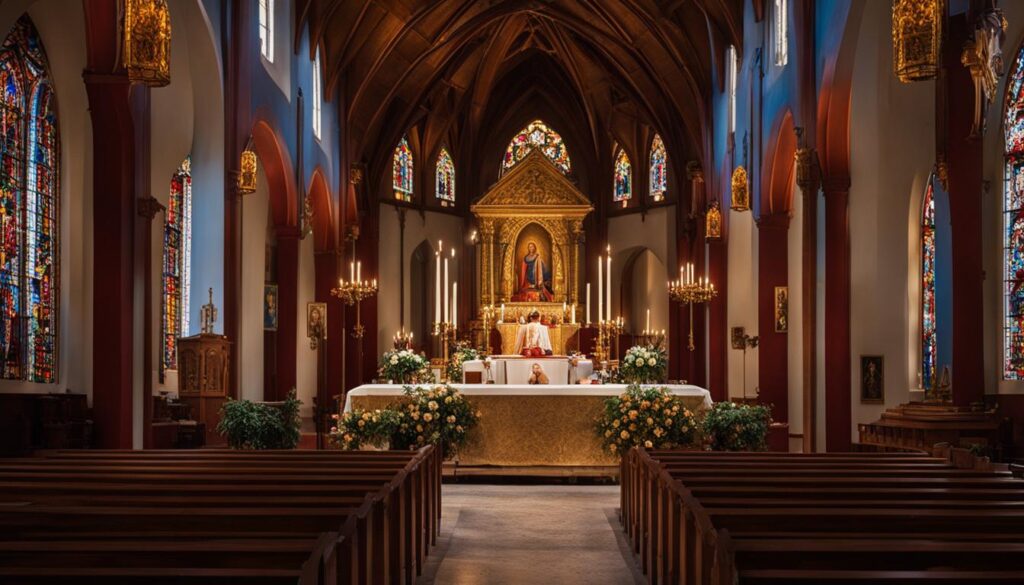As Christians prepare for Holy Week and Easter, the season of Lent offers a time of spiritual growth and reflection. Through various prayer practices, individuals can deepen their faith and draw closer to God. In this article, we will explore some effective prayer methods for the Lenten season.
Key Takeaways:
- Engage in personal reflective prayer to renew your spiritual journey.
- Turn your act of abstinence into a prayer-in-action by offering prayers of gratitude.
- Pray the Stations of the Cross to reflect on the passion and death of Christ.
- Practice Lectio Divina to deeply engage with scripture during Lent.
- Reflect on liturgical prayers during Mass to deepen your connection with the Church’s traditions.
Make Your Abstinence a Prayer-in-Action
Lent is a season of spiritual preparation, and one popular practice during this time is the act of abstinence. Many individuals choose to give up something as a sacrifice, symbolizing their commitment to spiritual growth. However, abstinence can also be turned into a prayer-in-action, deepening one’s connection with God and acknowledging the blessings in life.
Instead of simply refraining from the chosen item or activity, individuals can offer prayers of gratitude whenever they encounter it. This practice allows for a mindful reflection on the sacrifices made and fosters a deeper appreciation for the abundance of blessings in one’s life. By infusing abstinence with prayer, it becomes a transformative act that strengthens the spiritual journey.
“Abstinence becomes a prayer when we consciously recognize the sacrifices we make and offer prayers of gratitude in return.”
The act of making abstinence a prayer-in-action can take various forms. For example, if one chooses to abstain from consuming sweets, they can offer prayers of gratitude whenever they see or smell desserts. Similarly, if someone decides to give up social media, they can use the time saved to engage in prayerful activities or reach out to others in need.
By infusing abstinence with prayer, individuals not only deepen their connection with God but also cultivate a spirit of gratitude and mindfulness. This practice can bring about a profound transformation and spiritual growth during the Lenten season and beyond.
| Benefits of Making Abstinence a Prayer-in-Action |
|---|
| Deepens connection with God |
| Cultivates a spirit of gratitude |
| Fosters mindfulness |
| Strengthens the spiritual journey |
| Brings about profound transformation |
Engage in Personal Reflective Prayer
Lent is a time for spiritual renewal, and engaging in personal reflective prayer can help with this process. Taking the time to turn inward and connect with God on a deeper level can bring about a sense of peace, clarity, and a strengthened relationship with the divine.
There are various online resources available that can assist in jump-starting or reinvigorating one’s prayer life during Lent. For those seeking a quick daily retreat, 3-Minute Retreats provide a short guided reflection on scripture, inviting individuals to pause and reflect on God’s presence in their lives.
Additionally, the Seven Last Words of Christ guided meditation is a powerful and profound way to journey through the final moments of Jesus’ life. This reflection can deepen one’s understanding of Christ’s sacrifice and help individuals connect their own struggles and sufferings to the redemptive power of the cross.
Resources for Reflective Prayer
For individuals who prefer a more structured approach, Lent-specific prayer books can be a valuable resource. These books often contain daily reflections, prayers, and scripture passages designed to guide individuals in their Lenten prayer journey. Some popular options include “The Way of the Cross: A Lenten Journey with St. Paul” and “Praying with Ignatius of Loyola: Daily Reflections and Prayers for Lent.”
| Resource | Description |
|---|---|
| 3-Minute Retreats | A series of online guided reflections on scripture for quick daily retreats during Lent. |
| Seven Last Words of Christ Guided Meditation | A contemplative meditation on the final words of Jesus, allowing individuals to reflect on their own struggles and find meaning in the cross. |
| “The Way of the Cross: A Lenten Journey with St. Paul” | A Lent-specific prayer book that provides daily reflections, prayers, and scripture passages centered around St. Paul’s journey. |
| “Praying with Ignatius of Loyola: Daily Reflections and Prayers for Lent” | A Lenten prayer book inspired by the spirituality of St. Ignatius of Loyola, offering daily reflections and prayers for deepening one’s prayer life. |
Engaging in personal reflective prayer during Lent can help individuals find solace, guidance, and spiritual growth. Whether through online resources, guided meditations, or Lent-specific prayer books, taking the time to turn inward and connect with God can bring a renewed sense of purpose and nourish the soul during this sacred season.
Pray the Stations of the Cross
The Stations of the Cross is a powerful prayer practice observed during the Lenten season, particularly on Good Friday, to reflect on the passion and death of Christ. This prayer method allows individuals to follow Jesus’ journey to Calvary, contemplating the immense love and sacrifice He made for humanity. By meditating on each station, Christians can deepen their understanding of the Easter story and prepare their hearts for the upcoming celebration.
Stations of the Cross prayer services are often held in churches and parishes, providing a communal experience of walking with Christ on His journey. However, for those who prefer to pray at home or in a more personal setting, there are numerous online resources available. These resources offer detailed reflections, accompanying prayers, and even audio or video guides to help individuals engage with the Stations of the Cross in a meaningful way.
To make the most of this prayer practice, it is recommended to set aside a quiet space free from distractions. Consider creating a prayer corner or using a sacred image or icon of the Stations of the Cross as a focal point. Light a candle to symbolize Christ’s light and presence, and begin the prayerful journey by contemplating each station, reading the associated Scripture passages, and offering personal prayers or reflections for each. Allow the Lenten season and the Stations of the Cross to guide your heart towards a deeper connection with Christ and a renewed sense of faith.

Table: Stations of the Cross
| Station | Description | Scripture Passage |
|---|---|---|
| 1 | Jesus is condemned to death | Matthew 27:22-26 |
| 2 | Jesus carries His cross | John 19:17 |
| 3 | Jesus falls the first time | Isaiah 53:3-4 |
| 4 | Jesus meets His mother | Luke 2:34-35 |
| 5 | Simon of Cyrene helps Jesus carry the cross | Mark 15:21 |
| 6 | Veronica wipes the face of Jesus | Not mentioned in Scripture |
| 7 | Jesus falls the second time | Isaiah 53:3-4 |
| 8 | Jesus meets the women of Jerusalem | Luke 23:27-31 |
| 9 | Jesus falls the third time | Isaiah 53:3-4 |
| 10 | Jesus is stripped of His garments | Matthew 27:33-36 |
| 11 | Jesus is nailed to the cross | John 19:16-18 |
| 12 | Jesus dies on the cross | Luke 23:44-46 |
| 13 | Jesus is taken down from the cross | Mark 15:42-47 |
| 14 | Jesus is laid in the tomb | Matthew 27:57-61 |
Practice Lectio Divina
Lectio Divina, also known as “holy reading,” is a profound method of scriptural prayer that can deepen one’s communion with the Divine. This practice involves slow reading and meditation on a chosen text from the Bible, allowing the words to speak to the heart and nourish the soul. By engaging with scripture in this intentional and contemplative manner, individuals can experience a transformative encounter with God’s word.
During Lent, incorporating Lectio Divina into your prayer routine can help you enter into the spirit of the season and draw closer to God. Choose a passage from the Bible, perhaps one related to the themes of repentance, sacrifice, or redemption often associated with Lent. Set aside a special time and place for this practice, where you can be free from distractions and fully present to the scripture and the Divine.
“Lectio Divina has been an invaluable practice for me during Lent. By allowing the words of scripture to take root in my heart, I have experienced a deeper sense of connection with God and a greater understanding of His will for my life.” – John Doe
As you embark on your Lectio Divina journey, it can be helpful to follow a structured approach. Start by reading the chosen passage slowly and attentively, savoring each word and phrase. Then, take a moment to reflect on any word or phrase that stands out to you. This is often referred to as the “divine word” or the “sacred word.” Allow this word or phrase to sink in and repeat it silently as you continue to meditate on it.
In the final stage of Lectio Divina, move from meditation to contemplation. Let go of your own thoughts and allow God’s word to speak directly to your heart. Be open to any insights or promptings that arise. This practice can be both a source of solace and a catalyst for personal growth, inviting you to live out the wisdom and teachings gleaned from scripture in your daily life.
Benefits of Practicing Lectio Divina during Lent
- Deepens your spiritual connection with God
- Allows for a more profound understanding of scripture
- Provides a space for reflection and contemplation
- Encourages personal growth and transformation
- Brings a sense of peace and solace during the Lenten season
Reflect on Liturgical Prayer
When attending Mass during Lent, it is important to be conscious of and meditate on the words being prayed in the liturgy. Liturgical prayer holds a special place in the Catholic tradition and can greatly enhance one’s spiritual experience. Lent provides a unique opportunity to delve deeper into the meaning behind these prayers and develop a greater connection with God.
One of the key components of the Mass is the Eucharistic Prayer, which takes place after the Liturgy of the Word. This prayer is central to the celebration of the Eucharist and holds profound significance. It commemorates Jesus’ Last Supper with his disciples, where he instituted the sacrament of the Eucharist. During Lent, taking the time to sit and reflect on the words of the Eucharistic Prayer can open our hearts to a deeper understanding of Christ’s sacrifice and the transformative power of the Eucharist.
Additionally, the prayers and readings throughout the liturgy during Lent reflect the themes of repentance, sacrifice, and renewal that are central to this season. By actively engaging with these prayers, we can internalize their meaning and apply them to our own lives. As we participate in liturgical prayer, we become part of a larger community of believers, united in our shared faith and journey towards Easter.
Table: Key Prayers during Mass
| Prayer | Description |
|---|---|
| Introductory Rites | Opening prayers and hymns that prepare the congregation for worship. |
| Gloria | A hymn of praise to God, typically sung or recited at Masses. |
| Liturgy of the Word | Readings from the Old Testament, New Testament, and Gospel, followed by a homily. |
| Eucharistic Prayer | The central prayer of the Mass, which consecrates the bread and wine into the body and blood of Christ. |
| Communion | The distribution and reception of the Eucharist as a sacrament. |
By reflecting on liturgical prayer and actively participating in Mass during Lent, we can deepen our understanding of the significance of the Eucharistic Prayer and the transformative power of the liturgy. This season offers a unique opportunity for spiritual growth and renewal as we journey towards Easter.

Join or Start a Prayer Group
Praying with others can be a transformative experience that deepens one’s faith and fosters spiritual growth. Joining or starting a prayer group provides an opportunity for communal prayer, where individuals come together to support, encourage, and inspire each other on their Christian journey. Whether it’s with family members, close friends, or fellow parishioners, participating in a prayer group can offer a sense of community and provide valuable insights and perspectives.
By gathering regularly to pray and reflect, prayer groups create an environment where individuals can share their joys, concerns, and spiritual struggles. Through the practice of communal prayer, group members can draw strength and inspiration from one another, building meaningful connections and fostering lifelong friendships. Praying in a group also allows individuals to learn from each other’s experiences and deepen their understanding of faith.
A prayer group can take various forms, from small intimate gatherings to larger, more structured meetings. Some groups may choose to focus on specific prayer practices or themes, while others may rotate different prayer methods to provide diversity and spiritual enrichment. The key is to find or create a group that aligns with one’s spiritual needs and preferences.
Benefits of Joining a Prayer Group:
- Opportunity for communal prayer
- Support and encouragement from fellow group members
- Different perspectives and insights on faith
- Inspiration for spiritual growth
Tips for Starting a Prayer Group:
- Identify potential group members who share a common interest in deepening their prayer life.
- Determine the frequency and format of the prayer meetings, taking into consideration the availability and preferences of the group members.
- Establish a set of guidelines or expectations for the group, such as confidentiality, respect, and commitment to regular attendance.
- Select a location for the meetings that is conducive to prayer and reflection.
- Consider incorporating a variety of prayer practices and methods to cater to the diverse needs of the group.
- Provide resources, such as prayer guides or books, to assist group members in their prayer journey.

| Benefits of Joining a Prayer Group | Tips for Starting a Prayer Group |
|---|---|
| Opportunity for communal prayer | Identify potential group members who share a common interest in deepening their prayer life. |
| Support and encouragement from fellow group members | Determine the frequency and format of the prayer meetings, taking into consideration the availability and preferences of the group members. |
| Different perspectives and insights on faith | Establish a set of guidelines or expectations for the group, such as confidentiality, respect, and commitment to regular attendance. |
| Inspiration for spiritual growth | Select a location for the meetings that is conducive to prayer and reflection. |
| Consider incorporating a variety of prayer practices and methods to cater to the diverse needs of the group. | |
| Provide resources, such as prayer guides or books, to assist group members in their prayer journey. |
Develop a Daily Prayer Routine
Establishing a daily prayer routine during the Lenten season can be a powerful way to deepen your faith and experience a lasting spiritual transformation. By dedicating time each day to prayer, you create space for communion with God and nourishment for your soul.
To develop a successful daily prayer routine, it is important to find a rhythm that works for you. Consider starting your day with a moment of silence and reflection, setting the tone for a day filled with prayer. You can then incorporate prayer into different parts of your day, such as before meals, during your lunch break, or before going to bed.
A helpful resource to guide you in developing a daily prayer habit is a yearly prayer guide, such as “A Prayer Book of Catholic Devotions.” These guides provide a variety of prayers and reflections that can inspire and support your prayer journey. They can also serve as a reminder to stay consistent and committed to your prayer habits beyond the Lenten season.
Remember, a daily prayer routine is not about perfection but about cultivating a habit of seeking God’s presence in your life. As you dedicate time to prayer each day, you will find that your relationship with God deepens, your faith strengthens, and you experience the transformative power of prayer.
FAQ
What are some effective prayer practices for the Lent season?
Some effective prayer practices for the Lent season include making abstinence a prayer-in-action, engaging in personal reflective prayer, praying the Stations of the Cross, practicing Lectio Divina, reflecting on liturgical prayer, joining or starting a prayer group, praying with children or as a family, and developing a daily prayer routine that extends beyond Lent.
How can abstinence be turned into a prayer?
Abstinence can be turned into a prayer by offering prayers of gratitude whenever the thing being abstained from is encountered. This practice helps to deepen one’s connection with God and acknowledge the blessings in life.
How can I engage in personal reflective prayer during Lent?
You can engage in personal reflective prayer during Lent by using online resources such as 3-Minute Retreats and Seven Last Words of Christ guided meditation. Additionally, using Lent-specific prayer books can provide nourishment during this sacred season.
What are the Stations of the Cross?
The Stations of the Cross is a common tradition during Lent. This prayer method allows individuals to reflect on the passion and death of Christ, preparing for Good Friday observance and the Easter celebration. Stations of the Cross prayer services are often offered at local parishes, and there are also numerous online resources available for those who prefer to pray at home.
What is Lectio Divina?
Lectio Divina, also known as “holy reading,” is a method of scriptural prayer that involves slow reading and meditation on a chosen text from the Bible. By focusing on key words or phrases and allowing the scriptural word to speak in the heart, individuals can experience a deeper communion with the Divine. This practice can be a profound way to engage with scripture during Lent.
Why is it important to reflect on liturgical prayer during Lent?
When attending Mass during Lent, it is important to be conscious of and meditate on the words being prayed in the liturgy. For example, the Eucharistic Prayer, the highlight of each Mass, holds special significance during Lent. Taking the time to sit and reflect on this prayer can lead to a deeper understanding and connection with the Church’s traditions.
How can I join or start a prayer group?
You can join or start a prayer group by inviting family members, close friends, or even starting your own group. There are also prayer groups and circles sponsored by local parishes that can be joined. The Meeting Christ In Prayer kit provides step-by-step instructions and resources for beginners.
How can I develop a daily prayer routine that extends beyond Lent?
The Lenten season can be used as an opportunity to establish prayer habits that extend beyond Lent itself. Yearly prayer guides, such as A Prayer Book of Catholic Devotions, can assist in getting started and maintaining consistency. It is essential to find a routine that works for each individual and allows for a deepening of faith. By dedicating time each day to prayer, one can experience a lasting spiritual transformation.








